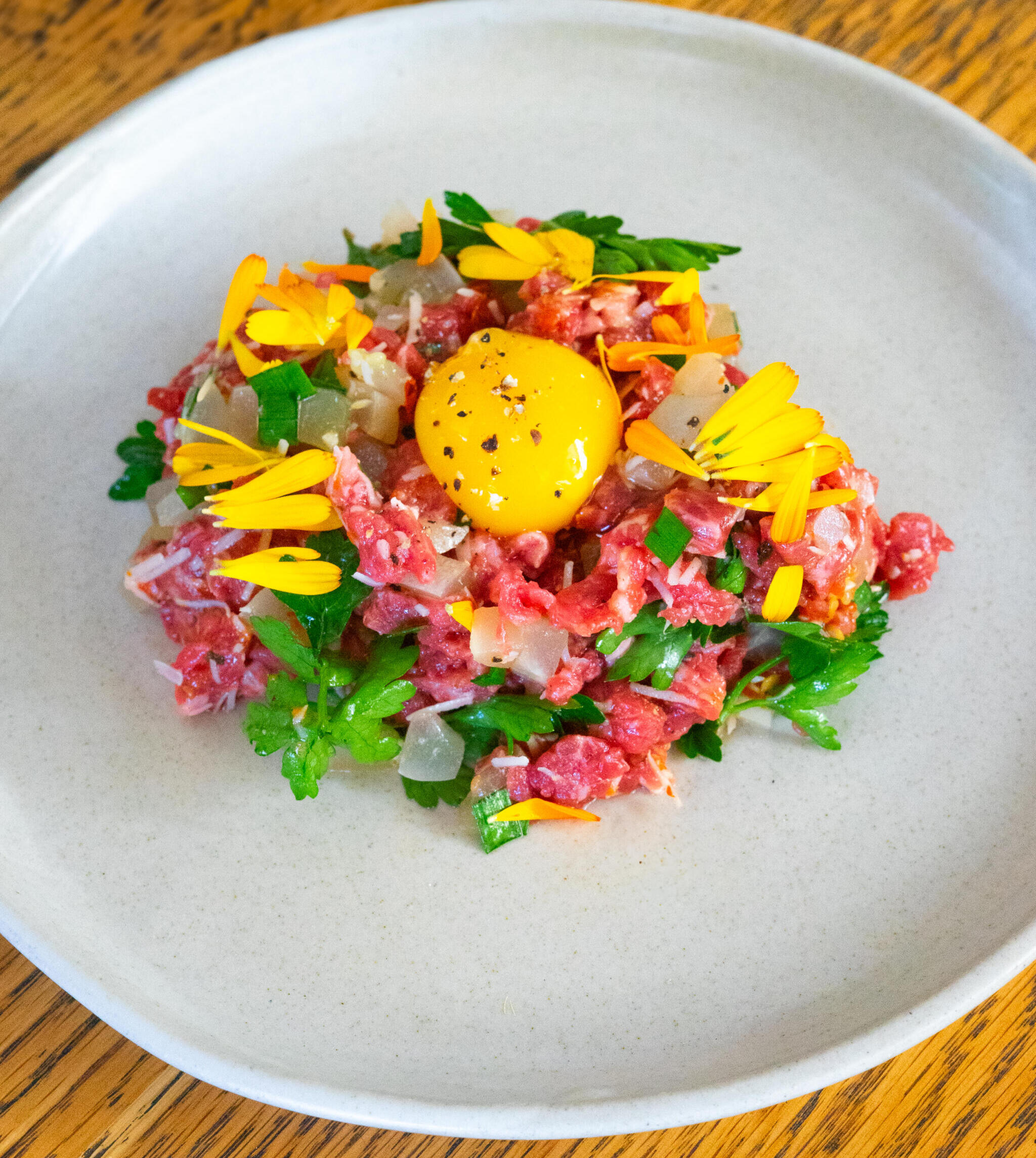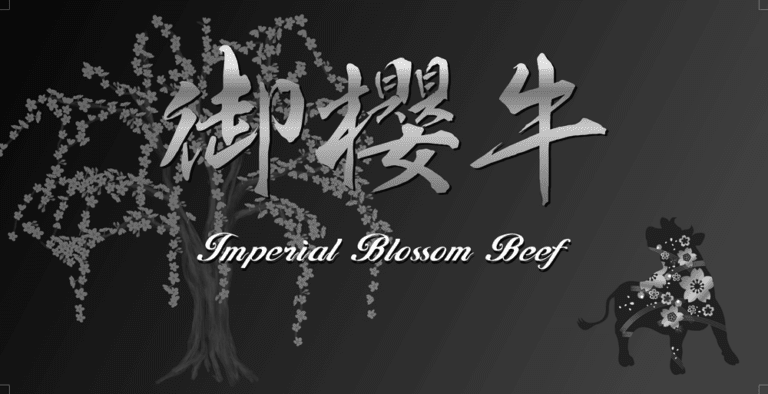
Grilled Stone Axe OP Rib, Seaweed Bearnaise, Coal Roasted Vegetables, Pepper Sauce (serves 2-4 pax)
Recipe by Shane Middleton, Head Chef of Papi Katsu Perth CBD Kombu -Jime +9 Stone Axe OP Rib 1 x

Wagyu beef is renowned worldwide for its unparalleled tenderness, rich flavour, and, most notably, its exquisite marbling. This marbling, the intricate pattern of fat distributed throughout the meat, is a key factor in determining the quality of Wagyu beef.
At Lux Wagyu House, we want to demystify the grading system, which can become confusing when factors such as colour, firmness, breed genetics, feed quality, aging processes and texture come into play so that you know what you’re looking for at your next purchase.
Wagyu beef grading is a meticulous process that takes into account several criteria, with marbling being the primary focus. The Japanese Beef Marbling Standard (BMS) is the widely accepted method for grading Wagyu, developed by the Japan Meat Grading Association (JMGA). BMS assigns a score to the marbling on a scale of 1 to 12, with 12 representing the highest level of marbling perfection.
Marbling refers to the intramuscular fat found within the meat. It is a defining characteristic of Wagyu beef, setting it apart from other types of beef. The marbling in Wagyu is not just fat; it’s a work of art. The fat is finely dispersed throughout the muscle fibres in a delicate web-like pattern, creating a buttery texture and imparting a rich, flavourful taste to the meat.
Colour:
Colour is a crucial aspect of Wagyu beef grading, influencing both the aesthetic appeal and the perceived freshness of the meat.
Firmness and Texture play a vital role in the overall eating experience of Wagyu beef. Well-developed muscle and the right level of firmness contribute to a satisfying bite. The texture and firmness of Wagyu beef are assessed to ensure that the meat is not overly soft or mushy. Proper texture is indicative of well-developed muscle and contributes to the overall eating experience.
Meat Brightness:
Meat Brightness is an aspect that reflects the freshness of the meat. The brightness of the meat, measured against a standardised background, is also evaluated. This criterion helps assess the meat’s freshness and overall quality. A vibrant and appealing colour enhances the visual appeal of Wagyu beef.
Texture of the Fat:
The texture of the fat is a finer detail that adds to the overall quality of the Wagyu beef. The fat is closely examined, with a smoother and more consistent texture being desirable. This criterion contributes to the overall aesthetic appeal of Wagyu beef.
Understanding and appreciating these factors allow consumers, chefs, and enthusiasts to not only identify high-quality Wagyu beef but also to recognise the craftsmanship and dedication involved in producing beef of such exceptional calibre. Each aspect, from the intricacies of marbling to the colour and texture of the meat, contributes to the unique and unparalleled dining experience that Wagyu beef offers.
Within the Wagyu category, Japanese Wagyu is often considered the gold standard. The Japanese grading system, established by the JMGA, classifies Wagyu into four primary categories: Japanese Black (Kuroge), Japanese Brown (Akaushi), Japanese Shorthorn (Nihon Tankaku), and Japanese Polled (Mukaku).
Japanese Black (Kuroge):
Japanese Brown (Akaushi):
Japanese Shorthorn (Nihon Tankaku):
Japanese Polled (Mukaku):
Within the Japanese Wagyu grading system, the A5 grade is the pinnacle of excellence. A5 is not only an indication of superior marbling but encompasses several additional criteria that contribute to the overall quality of the meat.
Yield Grade:
Yield grade, denoted by the letter A, B, or C, refers to the ratio of usable meat to the total carcass weight. A higher yield grade indicates a greater proportion of high-quality meat, contributing to a higher overall grade.
Quality Grade:
Quality grade, denoted by a number from 1 to 5, is a comprehensive evaluation of marbling, meat colour, texture, and other factors. A5 represents the highest quality grade, signifying exceptional marbling and overall excellence.
Beef Marbling Standard (BMS) Score:
The BMS score, ranging from 1 to 12, is a detailed assessment of marbling. A5 Wagyu must achieve a BMS score of 8 or higher, ensuring an extraordinary level of marbling and, consequently, an unparalleled dining experience.
In conclusion, the world of Wagyu beef grading is a fascinating intersection of tradition, precision, and culinary artistry. The more you look into the world of evaluating Wagyu, it becomes evident that the allure of this exceptional meat extends far beyond its marbling. The Japanese grading system, with its nuanced approach, ensures that each cut of Wagyu tells a story of careful breeding, meticulous care, and a commitment to excellence.
The pursuit of the A5 grade, the pinnacle of Wagyu quality, exemplifies the dedication of producers to deliver an unparalleled dining experience. From the vibrant colour and texture of the meat to the intricate patterns of marbling that define its tenderness and flavour, every aspect of Wagyu beef is scrutinised to uphold a standard of excellence that has made it a global culinary treasure.
As consumers, chefs, and enthusiasts, understanding the grading process adds depth to the appreciation of Wagyu beef. It invites us to savour not just the flavours on our plates but also the craftsmanship that goes into creating a product that stands as a testament to the intersection of nature and human expertise.
Whether you indulge in the renowned Japanese Black (Kuroge), relish the balanced qualities of Japanese Brown (Akaushi), explore the unique characteristics of Japanese Shorthorn (Nihon Tankaku), or savour the distinct appeal of Japanese Polled (Mukaku), each Wagyu variety brings its own story to the table. The journey from pasture to plate, marked by careful breeding, meticulous feeding, and a commitment to the highest standards, culminates in a dining experience that transcends the ordinary.
So, the next time you savour the buttery tenderness of a Wagyu steak, you’re not just enjoying a meal; you’re partaking in a legacy of excellence. The world of Wagyu beef grading invites us to appreciate the convergence of nature’s finest ingredients and human expertise, resulting in a culinary masterpiece that continues to captivate and delight taste buds around the globe.

Recipe by Shane Middleton, Head Chef of Papi Katsu Perth CBD Kombu -Jime +9 Stone Axe OP Rib 1 x

Recipe by Guy Jeffreys, Ambassador of Fogarty Wine Group and Kitchen Community Ingredients: 150g Lotte L’Grow Oyster Blade (MB 8






